This post may contain affiliate links. Read our disclosure policy.
I’m answering all your Cake Flour questions in this Cake Flour 101 article!
One of the questions I’m asked most frequently has something to do with the different kinds of baking flours on the market. What are they and why are they used for certain recipes?
Possibly the most important ‘specialty’ flour to understand is cake flour.

Free Buttercream Guide!
Frost your cakes and cupcakes perfectly with our Best Buttercream Guide. Trusted by 50,000+ home bakers.
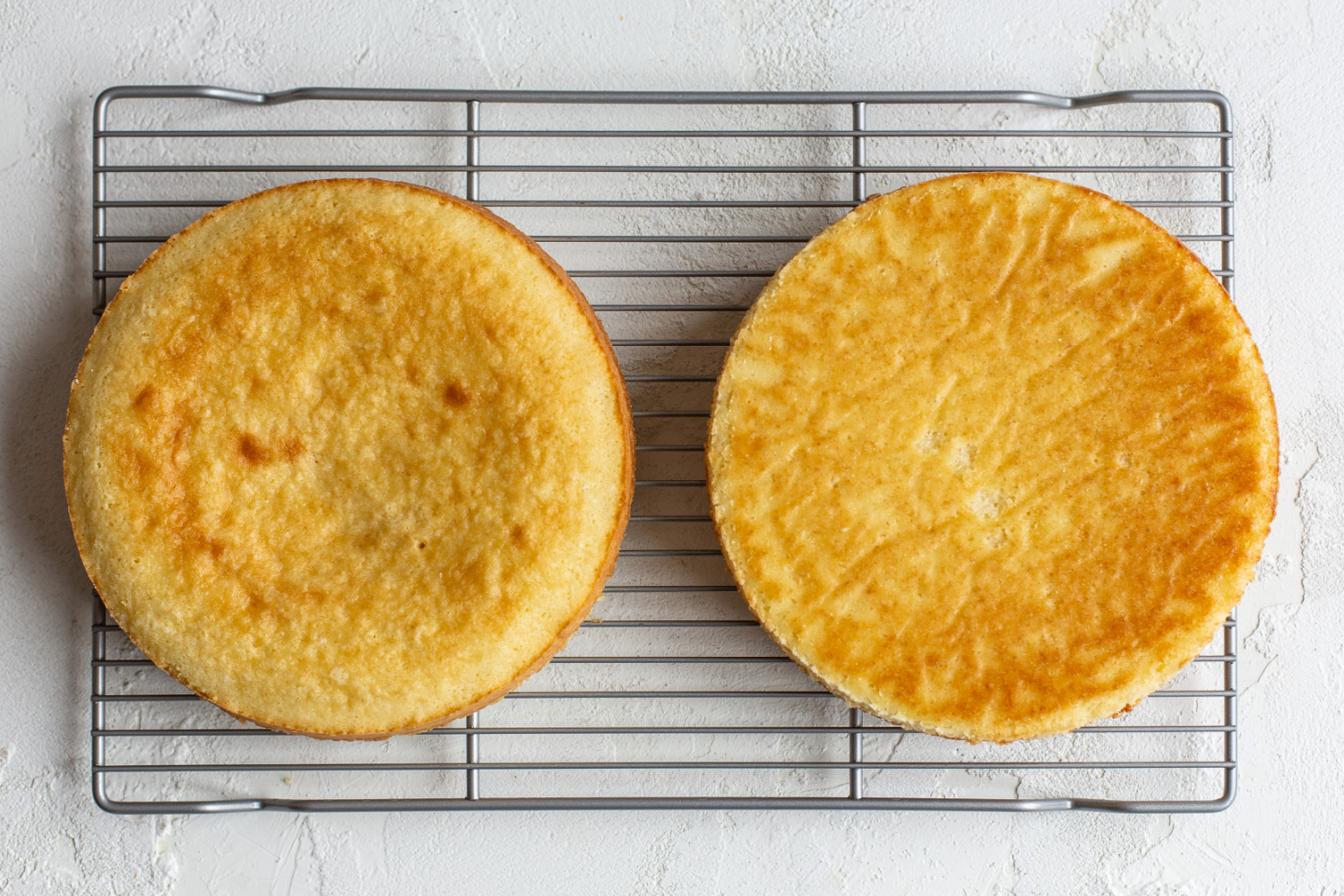
In fact, there are a couple recipes that I’ve made and some that I’ve published on the site that absolutely require cake flour. Using all-purpose flour instead will actually fundamentally damage the final result of the recipe. A good example of this is Angel Food Cake or even my Old-Fashioned Sour Cream Doughnuts.
Why is this? What is cake flour and how does it work?
In order to answer these questions for you, I went crazy in the kitchen baking up multiple batches of cupcakes with the specific intent of creating visuals that illuminate the science of this special flour in an easy-to-understand way.
Don’t get me wrong, sometimes it pains me to intentionally make batches of anything that I know aren’t going to come out exactly right, but the photos are so valuable. They actually show you how different ingredients and techniques impact your favorite treats. Sometimes the differences are shocking!
Quick side note: check out the HTH Science of Baking Headquarters for lots more delicious and fascinating kitchen experiments.
I don’t know about you, but I’m such a visual person that the best way I can learn about the magic and science of baking is by seeing it in action.
So, I not only experimented with different brands (and styles) of cake flour, but also how cake flour substitutions work.
Let’s get into the experimenting!

Sprinkle of Science
Cake Flour 101
What is Cake Flour?
Cake flour is very finely milled from soft wheat from the heart of the wheat endosperm. This helps to give cake flour its very fine silky soft texture. That fineness is actually why cake flour should be sifted before use as it’s more likely to clump together.
What’s the Difference Between Cake Flour and All-Purpose Flour?
The primary differences are that each flour is made from a different variety of wheat, milled to a different texture, and contain different amounts of protein vs. starch.
Cake flour has the lowest protein content of most flour products available:
- Bread flour: 12-15% protein content
- All-purpose flour: 9-12% protein content
- Pastry flour: 9% protein content
- Cake flour: 6-8% protein content
Protein content differs by brands and even styles of flour under the same brand. To figure out the protein content in any flour, divide the number of protein grams per serving by the number of total grams per serving.
This lower level of protein means cake flour also has more starch. Overall, the use of cake flour in a recipe will discourage gluten formation compared to a higher protein flour product. Lower levels of gluten equal more softness and tenderness in a baked good. Think of something that has a really high level of protein, like steak. It’s tough and chewy. When we want the opposite of that texture, we want lower levels of protein to achieve a soft and delicate crumb.
By contrast, this is why bread flour has more protein than all-purpose flour and certainly more than cake flour. Breads require that extra protein to form strong gluten webs that shape the backbone of a loaf and create that slightly chewy, bready texture.
Is Cake Flour Bleached or Unbleached? (This is important!)
Cake flour is typically bleached, which further weakens the proteins and prohibits gluten formation. Bleached flours in general soak up more water and produce thicker batters.
In the photos below, I actually tested Swans Down Bleached Cake Flour vs. King Arthur Unbleached Cake Flour to show you just how important this one detail can be! But before we get there, let me clear up some common misconceptions about bleached flour.
The bleached flour you buy at the supermarket does NOT contain chlorine in the final product. When flour products are chlorinated, manufacturers treat the flour with an extremely low level exposure to chlorine gas to provoke a chemical reaction. That chemical reaction not only changes the flour’s characteristics (more on that below) but it changes the chlorine itself. The chlorine turns into several other compounds: chlorite (which occurs naturally in unbleached flour), hypochlorous acid (found in our own immune cells), and chloride (an electrolyte found in a product like Smart Water). However, this is just one method of bleaching flour. You can learn more about flour bleaching here.
Bleached flour actually allows more moisture to be absorbed in a batter or dough to make dough less sticky and easier to handle. This can also help prevent excess spread in baked goods (think cookies). It improves the structure and height of cakes. It can make taller, sturdier breads. It also makes the flour more shelf stable and will not kill yeast.
There are tons of sources on this in scientific publications; here’s one on the safety of consumption.
Are Cake Flour and Pastry Flour the Same?
Where cake flour has a protein content of 6-8%, Pastry Flour is around 9% and has less starch than cake flour. Pastry flour is also typically unbleached unlike cake flour, so it will absorb less liquid in a recipe compared to cake flour. If you’re in a bind and only have pastry flour for a recipe that calls for cake flour, it’s better to use the pastry flour than all-purpose flour if you’re in a pinch.
Testing Cake Flour Substitutions
Tools & Ingredients Used for Experimenting
- I made every effort to replicate each batch as perfectly as possible, using the same exact tools and ingredients whenever applicable.
- I used a kitchen scale to measure ingredients to ensure 100% accuracy.
- Each batch was baked separately but in the same oven at the same temperature for exactly 20 minutes.
- I used Bleached Gold Medal All-Purpose Flour for the control batch and DIY cake flour.
- The two brands of cake flour I tested were Swans Down Cake Flour, which is bleached, and King Arthur Cake Flour, which is unbleached.
- Lastly, I baked the batches in my Wilton Cupcake Pan, using a large spring-loaded scoop to fill each cavity evenly with batter.
- All the cupcakes were baked on the same day to be photographed together. Before I reveal some of those photos, let’s cover the basics you need to know.
Pre-Experiment Thoughts & Predictions
The fact that cake flour is made from a different variety of wheat, milled differently, and is often bleached, makes it behave very differently than all-purpose flour in terms of how it affects the chemistry of a recipe. This also means it’s impossible to recreate cake flour exactly at home using “DIY” substitutions. That’s why I was so eager to compare side-by-side cake flour vs. all-purpose flour vs. DIY cake flour.
I had a suspicion of how this experiment would turn out, but I wanted to be 100% sure. I know many of us don’t always have cake flour in our pantries so it’s kind of an annoying ingredient when you see it called for in a single recipe! Yet, because of all of the baking experiments I’ve done, I know one small, seemingly insignificant change can have drastic results in baking.
Control Recipe with All-Purpose Flour
The cupcakes I baked were based on my standard cupcake recipe you can see at the bottom of this article. I re-made the same recipe each time, simply changing out the flour for each batch you see below.
These control cupcakes were soft yet sturdy with a slightly open crumb. They weren’t super tall and had some cracking on top that I think visually reflects the slight chewiness they had. Basic yet delicious and full of vanilla flavor.
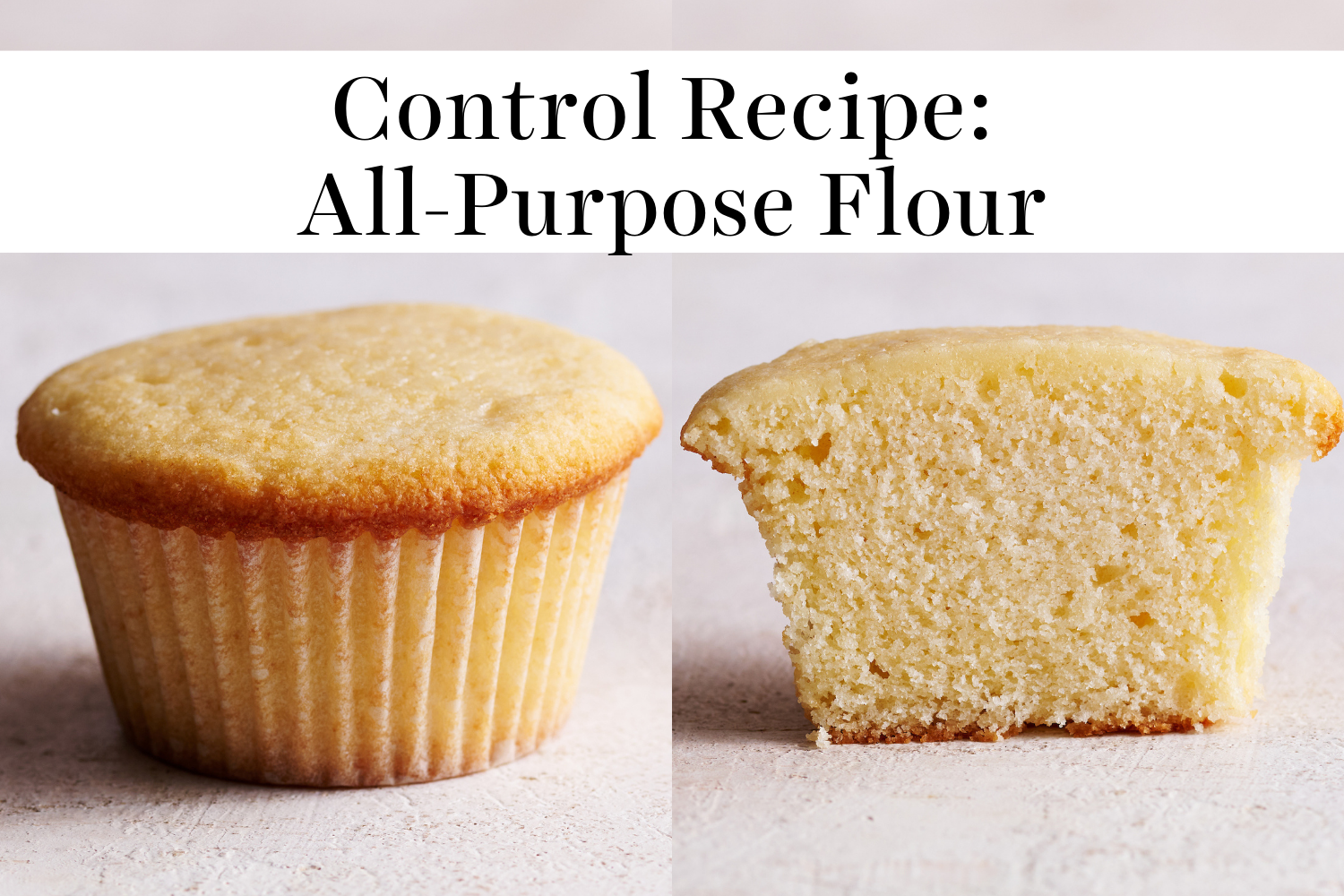
Experiment 1: DIY Cake Flour
Using the DIY cake flour technique just below, these cupcakes turned out visually more like the control / all-purpose flour cupcakes than the cake flour cupcakes. Their texture was another story. These were more crumbly and had an almost gritty texture which I’m attributing to the cornstarch. They almost felt like they dissolved in your mouth, which honestly, I didn’t care for. I won’t be using DIY cake flour in my baking… even if it’s a total pain to run to the store to grab cake flour!
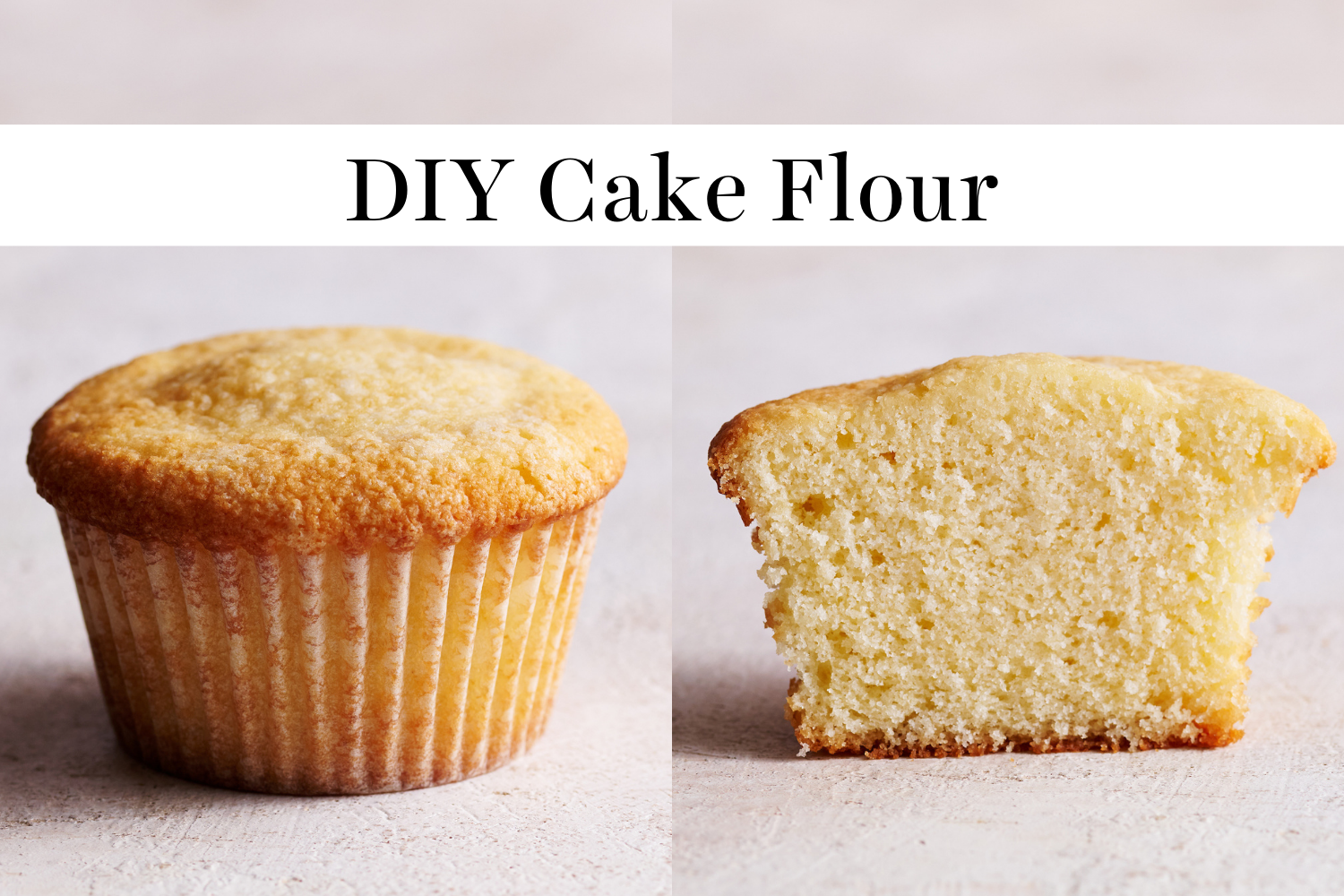


How to Make DIY Cake Flour
Although I would NOT recommend using DIY cake flour based on our experiment results, here’s how I did so:
- 1 cup minus 2 tablespoons all-purpose flour + 2 tablespoons cornstarch
- Then I sifted this flour + cornstarch mixture 5 times with a fine mesh strainer.
Comparing Brands of Cake Flour: Which is the Best?


Experiment 2: Swans Down Cake Flour (Bleached)
I used the same amount of Swans Down Cake Flour in place of the all-purpose flour in this batch. These cupcakes baked up pale and tall with a spongier and softer texture. The softness actually reminded me slightly of a more commercially produced cupcake – but not necessarily in a negative way. They were so soft and delicate that I don’t think they’d hold up well to a heavy or generous frosting or filling. They also had a slightly less pronounced vanilla flavor than the all-purpose flour cupcakes.

Experiment 3: King Arthur Cake Flour (Unbleached)
I was SO excited to see the comparison between the Swans Down and King Arthur Flour cupcakes to see what impact bleaching had on the final result, among other variances between the two brands.
Although I love King Arthur as a brand, the cupcakes made using KA’s flour were noticeably less flavorful than the all-purpose cupcakes. Compared to the Swans Down cupcakes, the King Arthur cupcakes had an almost cornbread texture. I’ll be sticking with Swans Down when I need to use cake flour.


Cake Flour vs. Substitutions Final Comparison


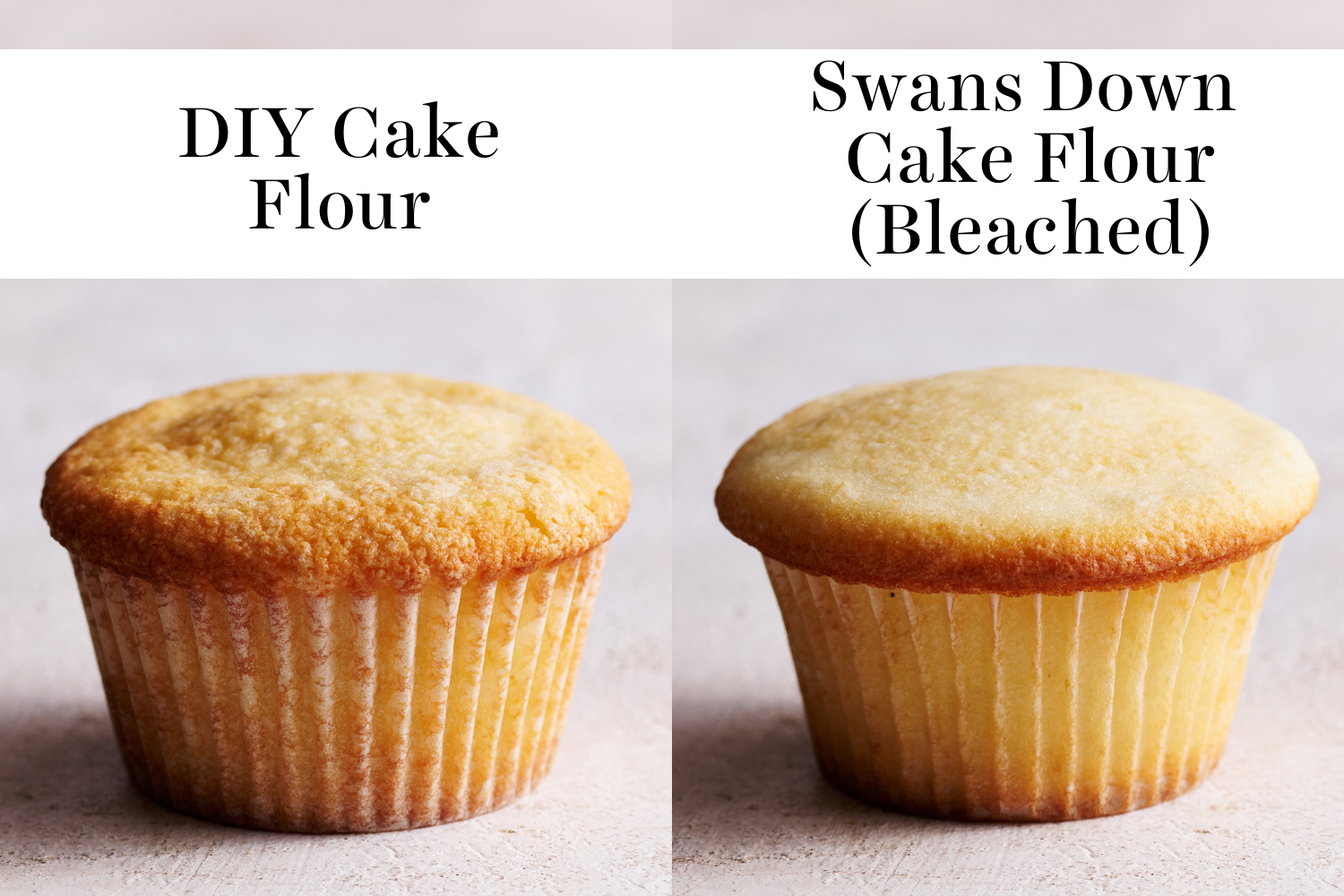



Personally, I tend to prefer cupcakes made with all-purpose flour instead of cake flour. However, for some recipes like Angel Food Cake or certain cakes formulated to use cake flour, it helps to create that fine and delicate crumb characteristic of that style of recipe. In those cases, it really shouldn’t be substituted!
I think visually, these comparisons do a good job of proving the belief I’ve always held that nothing is quite as good as the real thing.
Can Cake Flour be Substituted?
It shouldn’t be. Recipes that use cake flour are typically more delicate and finicky and require the exact ingredients called for.
In fact, 90% of substitutions you make in baking will alter the taste and texture of the final result. Sometimes substitutions are necessary, and I understand that. However, the Handle the Heat method of baking recommends that you always follow the recipe exactly as it’s written… at least the very first time you make it, so you know how it’s supposed to turn out. Then you can experiment with substitutions and alternatives as needed once you have that baseline.
Does Cake Flour Go Bad?
Luckily, since cake flour is refined and bleached, it will keep in your pantry for a long time. If stored in a cool and consistently dry and airtight place, it should last at least 6 months if not up to a year. So why not have some on hand for those few recipes that use it so you can really take your baking to that next level?
Recipes Using Cake Flour:
- Funfetti Sheet Cake (instructions included for making as cupcakes!)
- Old-Fashioned Sour Cream Doughnuts
- Best Yellow Cake
More Baking Science Articles:
- How to Prevent Cakes & Cupcakes From Sinking
- Buttermilk 101
- Baking Soda vs. Baking Powder
- Best Baking Pans
- Ultimate Guide to Chocolate Chip Cookies

Control Cupcakes
Email This Recipe
Enter your email, and we’ll send it to your inbox.
Ingredients
- 1 1/2 cups (191 grams) all-purpose flour
- 1 1/4 teaspoons baking powder
- 1/4 teaspoon fine salt
- 1 cup (200 grams) granulated sugar
- 1 stick (113 grams) unsalted butter, at room temperature
- 1 large egg
- 3/4 teaspoon vanilla extract
- 1/2 cup plus 2 tablespoons whole milk
Instructions
- Preheat the oven to 350°F. Line a standard 12-cup muffin tin with paper liners.
- In the bowl of an electric mixer, beat the sugar and butter until light and fluffy, about 3 minutes. Scrape down the bottom and sides of the bowl with a rubber spatula. Add the egg and vanilla and beat until combined. Scrape down the bowl again. Add the dry ingredients and milk alternatively, starting and ending with the flour, beating well after each addition. Continue beating for one minute. Using a spring-loaded scoop, divide the batter between the cupcake cups, filling each about 2/3 full.
- Bake for 15 minutes, or until a toothpick inserted comes out clean. Let cool for 10 minutes before removing to a wire rack to cool completely.
Recipe Notes

The Ultimate Cookie Handbook
Learn the sweet SCIENCE of cookie baking in a fun, visual way to customize your own recipes frustration-free. Plus, my best 50+ homemade cookies!
Photos by Joanie Simon | The Bite Shot



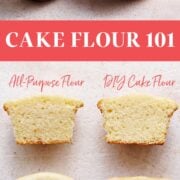






















I haven’t made the recipe but was intrigued with the comparison. With that said, I’m making a strawberry and cream cupcake for 8/28/21 outside wedding. I will actually cut be cutting the top off and placing “whipped cream” with fresh strawberries on base and retopping it and dust with powdered sugar.
What would you use for the “whipped cream” so it stays well and not melts?
I’ve researched stabilized whipped cream and thickened Cool Whip recipes.
Thank you,
Carol Roberts
Hi Carol! Tessa likes using this Stabilized Whipped Cream recipe; however, you definitely want to make sure your cupcakes are kept in cold storage for as long as possible and also kept out of the sun! Hope that helps, your cupcakes sound absolutely delicious!
Is there any ways to lower the protein in unbleached cake flour? I tried adding in corn starch but the outcome of my cake is still heavy and dense 🙁
Honestly, I always recommend using bleached cake flour. While adding corn starch might dilute the protein, it also increases the starch in a totally different way, which can make a cake that bakes up heavy and dense.
I moved to New Zealand a few years ago and just today noticed the protein difference between US to NZ “all-purpose” flours, as well as every known brand of flour to man. Why can’t there be a fixed standard? Or why can’t flour be identified by the number of protein percentage? In both recipes and on the store shelves? (rhetorical questions for complaining purposes only)
Thank you for your flour substitution test! I came across it yesterday, which lead to today’s discovery. Hopefully the information leads to better baking.
I have a cookbook with cake recipes calling for “cake and pastry flour.” I’m stumped. I think it’s a Canadian thing, but now that Bob’s Red Mill has nixed their cake flour and King Arthur’s cake flour is high in protein and the two supermarket brands are more like 7%, I’m pretty much left with pastry flour. King Arthur sells in 3 lb bags and it’s costly, and Bob’s Red Mill is 8.5-9%. What should I use that I can actually buy? I know the southern brands of AP flour are at the sweet spot, but they’re expensive too. Please help. Should I just use the Bob’s pastry for cakes calling for “cake and pastry flour.”
Here in the UK we have plain flour, which I assume equates to US all purpose flour, I’ve also seen something called extra fine sponge flour, which I’ve never used but is described as being extra fine from British soft wheat varieties. Would this equate to your cake flour? Both types seem to be the same protein content.
It sounds like it would, but I’m really not sure as I have no personal experience with it.
Hallo Mary, I live in the UK too and, as far as I know, all-purpose flour is plain flour plus baking powder (or is it soda bicarbonate?). Fine sponge flour is for sponges only.
Hi Beatrice! All-purpose flour in the U.S. doesn’t contain baking powder, it equates to UK’s plain flour. I think what you’re thinking of is called self-rising flour, which includes a bit of baking powder and salt in its mixture (Tessa doesn’t use self-rising flour as she prefers the customization and flexibility to make her own mixup of ingredients [flour and leavener/salt] and not have to rely on whatever the manufacturer made in their container of self-rising flour.). We’re unfortunately not familiar with other flours in the UK, I wish we could help find an equivalent!
Oh, right. Thanks. Sorry for the confusion!
I have a question on the cake flour where eating over-processed foods is a concern. By default, bleached cake flour is one of the most processed versions of flour that we can use. How would someone who cannot properly digest this type of flour compensate with the use of other flours?
On a similar note – Would you have any suggestions in regards to gluten free options (coconut flour, almond flour, etc…)?
Thanks!!
Have you found an organic cake flour? You should consider doing a test batch comparing organic whole wheat pastry flour to cake flour.
Keep doing your experiments we both love the information!!! We (we both love to bake) find your information both insightful and accurate. One of our favorite recipe is making Banana Bread (we live on the Big Island of Hawaii) and since we use whole apple-bananas the bread tends to come out with uneven texture. Now we are going to try both the DIY and the real cake flour to see if it makes it better. BTW we found freezing the banana pulp for a few days improves the flavor and evens out the moisture content problem. It also helps to freeze carrots for carrot cake. Try that for an experiment, you and your readers will be shocked at the results !
I love this experiment! Helped me a lot. I am opening my own bakery and I used to bake using cake mixes, but now I am going all made-from-scratch, so I have been doing a lot of experimenting- it is a learning curve, but well worth it!
Could you do a test comparing cake flour and sponge flour please? Thanks.
I would like to see comparisons using bleached an unbleached flours.
Thanks!!!!
I would like to see comparisons using bleached an unbleached flours. When baking cookies, I use unbleached flour. Also, thank you for this article using cake flour. The next time I bake cupcakes, I will use it.